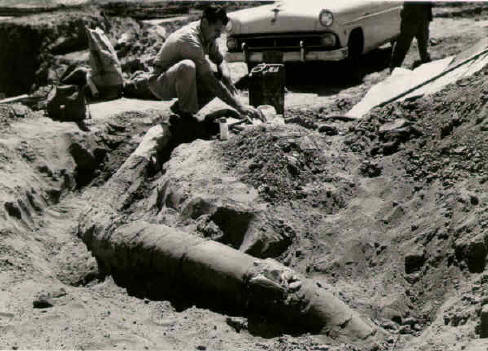|
Chapter 5. Identifying and Naming a New
Species
From site T2 the boys had dug remains of plants, invertebrates’ fishes,
frogs, toads, turtles, seals, camels, horses, badgers, deer, several kinds of
rodents, a fragment of a mastodon tooth, and a section of a mammoth tusk.
the figure below shows a tusk similar to the one excavated by the group.
 |
| Workmen digging for clay
uncovered this 10.5 foot section of a mammoth tusk. The
tusk was probably about 13.5 feet long. To keep it from
breaking, Dr. D.E. Savage is applying burlap (soaked in plaster
of Paris) to the specimen. |
On a particular Saturday one of the group was striking gently through the
sand at sire T2. Suddenly he hit something. He put aside the pick and contained
working carefully with a knife. Frequently he used a toothbrush to clean away
the sand. Soon teeth were exposed. Work proceeded rapidly because the sand was
fine and dry. In about twenty minutes the specimen was picked up and the sand
underneath gently brushed off. It was a lower jaw bone with five teeth intact so
well preserved that the application of a preservative (shellac) was unnecessary.

The structure of the lower jawbone of
coyote from Locality V3604, site T2, indicates tthat the coyote
had four premolars (P_) and three molars (M_). The first
premolar (P1) and the last molar (M3) are
missing. The distance between the second premolar (P2)
and the second molar (M2) was one of the measurements
taken to determine the species of this fossil. (To indicate
a molar in an upper jaw, the numeral is placed above the line. M1,
for example, would would indicate the first molar in an upper jaw.
|
The jaw’s first premolar and last molar were missing. Noting the holes
where these teeth had been, one of the boys commented, “That’s some kind of
dog.”
“Yes, but it’s too small to be dire wolf,” added another boy.
“It can’t be fox, either. Too small,” said the director. The newest
member of the group said he was sure it was some kind of dog because it
resembled a modern dog jaw. But they all agreed the specimen represented an
animal they had never found before.
As was his custom, the director took the specimen to Berkeley for
identification. Donald E. Savage, who was studying and describing the Irvington
fauna, examined the specimen and found it to be a coyote (Canis).
The boys were right; the animal was a dog. But after further study, Savage found
that it had dome unusual features. Did this specimen represent a type of coyote
new to science? He knew that many weeks of work would be necessary before he
could be certain.
|